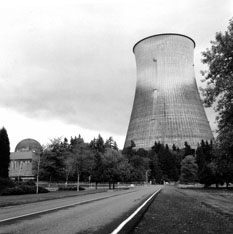Federal support for nuclear in the oil sands
 Calgary, Canada (GLOBE-Net) – Federal Natural Resources Minister Gary Lunn has said that Canada will almost certainly use nuclear power to supply the Alberta oil sands industry’s huge energy demand.
Calgary, Canada (GLOBE-Net) – Federal Natural Resources Minister Gary Lunn has said that Canada will almost certainly use nuclear power to supply the Alberta oil sands industry’s huge energy demand.“It’s not a question of if, it’s a question of when in my mind,” Lunn told Sun Media reporters. “I think nuclear can play a very significant role in the oil sands. I’m very, very keen.” “On this specific file, I’ve had discussions this week,” he added. “It’s absolutely emission free. It’s CO2 free.”
Lunn spoke in support of a partnership between Atomic Energy of Canada Limited (AECL) and a private Alberta company to build a CANDU (CANada Deuterium Uranium) reactor in the province. Calgary-based Energy Alberta Corp. reported earlier this year that it has a two-year exclusive deal with AECL to sell the CANDU 6 reactor (and the idea of nuclear power) to oil companies. The company said it has started talks with six firms, including EnCana Corp., Husky Energy Inc. and Total SA of France. The oil sands hold an estimated 175 billion barrels of recoverable crude reserves - placing Canada second in the world behind Saudi Arabia. As the bitumen is locked in sand, sometimes underground, it takes tremendous amounts of energy to extract and refine the oil sands into a usable product.
Much of this energy comes from natural gas, with the Alberta government reporting that 1 to 1.25 gigajoules of the fuel is required to produce one barrel of bitumen using Steam Assisted Gravity Drainage (SAGD), a commonly employed method. Current greenhouse gas emissions from the industry are around 35 Megatonnes of carbon dioxide equivalent, close to 5 percent of Canada’s total emissions.
Production from the oil sands is expected to triple to nearly 3 million barrels per day by 2015, with greenhouse gas emissions projected to double. A report from the National Energy Board predicts that natural gas will continue to supply the bulk of power to the region, but improvements in gasification technology could result in a shift in energy sources; bitumen and coke will be converted into clean burning synthetic gas – ‘syngas’ – in a new SAGD project that could lead to further development in this area.
See articles: Oil sands production to triple and Developing a Shared Vision for Oil Sands development.
The industry has been somewhat cautious about nuclear energy because of the huge capital cost involved in constructing a plant. But recent comments by industry representatives and government officials suggest the idea is becoming more acceptable.
The proposed plant would cost around $2.8 billion to build, and would allow production of approximately 200,000 barrels of oil per day. Should the project receive approval, which could take until 2009, the plant could be in operation by 2014.
While outgoing Alberta Premier Ralph Klein was vocal in his support of nuclear, Environment Minister Guy Boutilier has been less enthusiastic. Boutilier has said that with the province rich in other sources of energy – oil sands, coal, natural gas and wind – nuclear is at the bottom of the priority list. Renewable energy is a more important “strategic goal”, he said earlier this year. Incoming Premier Ed Stelmach has said that nuclear should be considered.
Canada is well stocked with nuclear resources, holding 12% of the world’s estimated uranium reserves and producing around one-third of the world’s uranium mine output, which in 2004 amounted to 13,676 tonnes valued at close to $800 million.
The CANDU reactor has been instrumental in the development of our domestic nuclear energy industry and has been the basis of our international reputation for expertise in this area. All reactors in Canada are of CANDU design, as well as 8 percent of those used in OECD countries.
You can return to the main Market News page, or press the Back button on your browser.

